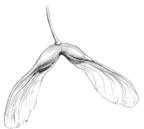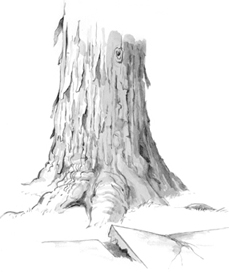SILVER MAPLE
Acer saccharinum

IMPORTANCE: A venerable big tree on American streets. Widely planted by earlier generations for its quick growth, shady spread, handsome two-toned foliage, and shaggy bark. Controversial for its tendency to break under stress.
FAMILY: Aceraceae (Maple). GENUS: Acer (maple).
COMMON URBAN SPECIES:  Silver maple (Acer saccharinum) or soft m., silverleaf m., river m., creek m., swamp m., water m., white m., papascowood.
Silver maple (Acer saccharinum) or soft m., silverleaf m., river m., creek m., swamp m., water m., white m., papascowood.
CLOSE RELATIVES:  Red maple (Acer rubrum).
Red maple (Acer rubrum).
TYPICAL CITY LOCATION: Along residential streets, moist lowlands in parks, waterways, spacious yards, campuses.
KEY FEATURES: A soaring tree with short trunk, often divided into multiple trunks. Massive limbs form Y-shaped crown with flattish top. On older trees, shaggy, silver-gray bark curls away from tree in vertical strips.
Leafblade has 5 long points (lobes), deeply cut indentations (sinuses) between the points, dramatically jagged edges; medium green on top and contrasting pale silver-green on bottom. To 7″ long and wide.
Late-winter twigs sprout reddish bud clusters, clumpy and conspicuous. Leaves then appear in thick clusters.
Fruit is a double-winged samara, or single wing with aborted second wing. Up to 3″ long and quite broad, wing is largest of maple “whirlybird” wings.
AVERAGE MATURE SIZE IN CITY: 40–70′ high, 35–50′ wide, 1½–2½″ thick.
RECENT CHAMPION: 61′ height, 82′ spread, 32′ circumf., Polk City, La.
 BIG, BEAUTIFUL, AND BRITTLE
BIG, BEAUTIFUL, AND BRITTLE
… it is a favorite, for it … adds a century to the appearance of a village street.
—Donald Culross Peattie
Urban foresters develop what they call “hit lists” of trees to eliminate from street plantings. High on such lists is the silver maple, a species so beloved by earlier generations that today it towers over thousands of American streets, its abundant, wind-tossed foliage undulating between bright green and silver-green. In Washington, D.C., alone, 11,000 silver maples were planted along the streets in 1883.

Red, radish-sized clusters of silver maple buds in early spring.
Deeply indented silver maple leaf is pale green on its underside.
Too much wind, however, or a crushing ice or snow load, and something snaps in this beautifully composed and friendly giant. Pray that you are not beneath a silver maple when this happens.
Yet, here is a tree that gives lavishly to those who embrace it. A native of moist eastern soils, it grows like magic in cities as in woodlands. Within 20 years, it reaches 50 feet and provides the shade of a majestic tree. In late winter, clusters of small red buds appear on the twigs and swell to the size of radishes, so abundant that the loaded branchlets look like kabobs. Among the first to blossom on city trees, these clumsy buds are as welcome as the sound of baseball. The clusters turn yellowish as their minute flower parts emerge.
Next come the leaves, white folds at first, then green blades as sharply cut as crystal ware (see figure). The leafblade looks more like a five-pointed (five-“lobed”) star or splayed hand than the typical maple leaf with broad lobes. Its indentations (sinuses) are deep enough to qualify as “cut-leaf,” a deluxe feature in the tree trade but free with your silver maple. The leaf’s underside, pale as pistachio ice cream, also sets it apart.

Silver maple samara with its veiny wings.
The leafblades hang in clusters from long, droopy stalks. Fall colors, if any, tend toward unspectacular yellow or orange. Sometimes the leaf tips alone turn cherry red.
A mature silver maple can be identified also by its shaggy bark. Long, vertical, silver-gray strips curl away from the tree at each end, as though slapped on with cheap paste. Vandals can yank these ends free, though the center of the strip may be well attached.

Roots of shaggy-barked silver maple like to heave sidewalks.
The silver maple fruit develops before the leaves are fully unfolded. As with other maples, it takes the form of a double wing, but often develops one jumbo (up to three inches long) and one stunted wing, the large wing falling separately. As delicately veined as insect wings, they are designed to whirl as they descend. To view the plump seed kernels, break the pair of wings apart and pry open the swollen ends. Don’t feel guilty—the tree’s huge seed production is one of the knocks against it in cities.
MY SWEET EMBREAKABLE YOU
Saccharinum is the scientific name for the silver maple species. As you might guess, it means “sugary,” and a superior, fine-grade maple syrup has been another of the tree’s gifts. Syrup tapping is not a big part of urban life, however, and does not get this generous tree off the hit lists.
Why are urban foresters gunning for it? The problem is that silver maples break. The wood is hard but brittle. As if the tree cannot accept this tragic flaw, it wants to grow to heights of 100 feet or more. It wants to launch massive upsweeping limbs. It wants to divide a few feet up its trunk into two or more subtrunks bearing enormous numbers of heavily loaded branchlets.
What happens? A stress trauma, and parts of the tree break like candy cane. Branchlets litter the street after a mean wind. A dump of wet snow or freezing rain can take down limbs the size of girders. (This writer once woke to see his subcompact KO’d by a medium branch.) Double or triple subtrunks growing from a short trunk may simply crack apart, like a wishbone. Some say the danger is exaggerated, but these things do happen. Not all at once, but one can see the accumulated damage in winter, when the tall silver maples reveal their amputations and other war wounds.
The tree has minor flaws, too. Its many annoying diseases and pests include wilt, scale, and, lately, Asian longhorned beetle. The wood develops cavities. Lumpy burls and sprouts appear on the trunks. Aggressive surface roots can play havoc with sidewalks and sewers. Young twigs smell a bit like the grave when broken. The tree—so vigorous in its growth that biomass-energy researchers are looking into it—rates only so-so in longevity.
But life is made of trade-offs, and sometimes the romance of big, graceful trees can excuse a multitude of sins. Tree lovers admire not only the upsweeping branches and full crown of the silver maple, but also its distinctive motion, the heavy waves of green and silver that ride the breezes. Songbirds and squirrels flock to it. It is a highly adaptable tree that has grown vigorously even on the streets of western cities. Like certain actors, it sometimes seems more appreciated in urban Europe, where the imported strain turns a sophisticated yellow in October.
Cultivators have developed seedless and less damage-prone hybrids. ‘Silver Queen’ is a popular variety, with structurally better trunk and branch formation. But the hybrids generally come up short on growth rate and grandeur.
Some experts feel that with timely pruning—of early secondary trunks, for example—the tree would be safe enough in open city spaces. But urban landscapers face a particular menace of our times: liability and lawsuits. Thus, the balance tips against new silver maples on the streets. Planting them there is not only discouraged; in many communities it has been outlawed.
